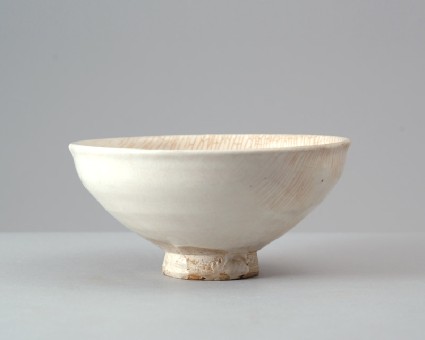Browse: 161 objects
White ware bowl
- loan
-
Details
- Associated place
-
Asia › China › Cizhou kiln-sites (place of creation)
- Date
-
11th century (1001 - 1100)
Northern Song Dynasty (AD 960 - 1127)
- Material and technique
- stoneware, thrown, covered with white slip, under a transparent white glaze; unglazed base; glazed rim
- Dimensions
-
7 cm (height)
14.2 cm (diameter)
- Material index
- Technique index
- Object type index
- No. of items
- 1
- Credit line
- Lent by the Sir Alan Barlow Collection Trust.
- Accession no.
- LI1301.152
-
Further reading
University of Sussex, and Arts and Humanities Research Council, The Barlow Collection, supervised by Regina Krahl, Maurice Howard, and Aiden Leeves (Sussex: University of Sussex, 2006), no. C128
Glossary (3)
glaze, slip, stoneware
-
glaze
Vitreous coating applied to the surface of a ceramic to make it impermeable or for decorative effect.
-
slip
A semi-fluid clay applied to a ceramic before glazing either to coat the surface or for decorative effect.
-
stoneware
Ceramic material made of clay which is fired to a temperature of c.1200-1300⁰c and is often buff or grey in colour.
Location
-
- currently in research collection
Objects are sometimes moved to a different location. Our object location data is usually updated on a monthly basis. Contact the Jameel Study Centre if you are planning to visit the museum to see a particular object on display, or would like to arrange an appointment to see an object in our reserve collections.
Publications online
-

The Barlow Collection
White-slipped stonewares of this type with red-stained crackle are associated with finds of the 1920s at Juluxian in Hebei province, a city destroyed by floods in 1108.
The rounded bowl tapers towards a tall, thickly cut, slightly splayed foot and has a slight groove below the flared lip to afford a better grip. The coarse buff-coloured stoneware body is thickly covered with white slip and with a transparent glaze whose regular crazing across the piece has been stained reddish through immersion in red soil. The slip ends well above the foot, the creamy-white glaze reaches down somewhat further, both ending in uneven lines. The footring is exposed in the biscuit, and the base and inside of the foot bear slip but no glaze. The inside shows three small spur marks roughly corresponding to the size of the foot, suggesting that the piece was fired in a stack.
© 2013 University of Oxford - Ashmolean Museum




